Wonu Veys travelled to Australia as part of an international collaborative project entitled Globalization, Photography, and Race: The Circulation and Return of Aboriginal Photographs in Europe. She has worked extensively with the photographic collections found within the Musée du quai Branly, but more specifically with pictures from the Museum of Ethnology.
The following is a blog account of Wonu’s travels that have been translated from Dutch to English.
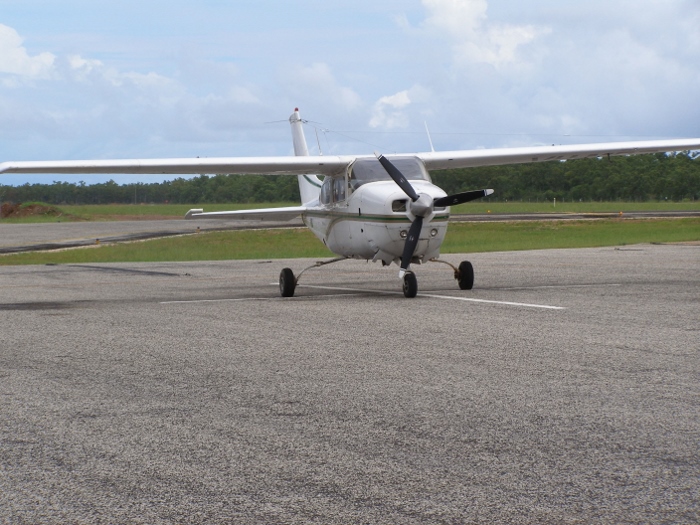
The plane that will take me to Numbalwar
In Numbulwar (Monday, February 24, 2014)
My journey to Numbulwar begins today. The community was founded in 1952 by the Church Missionary Society, and has mainly been settled by the Nunggubuyu people. By 1964, just about all Nunggubuyu lived in Rose River Mission, as the place was then called. This name was later changed to Numbulwar.
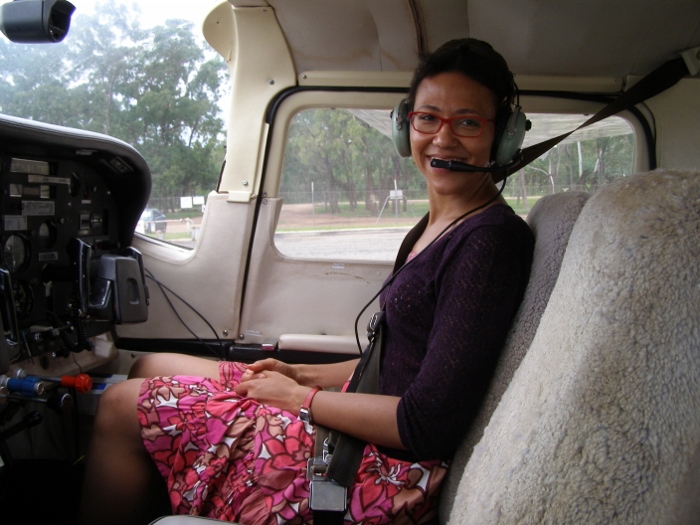
Wont with headphones to communicate with the pilot
During the Dry Season (starting around the month of May), I could have reached the settlement on land via a 10-hour trip from Darwin. For this trip however, I was required to fly into the community.
My first flight went from Darwin to Groote Island via Vincent Aviation. The plane was almost completely full with its 16 passengers. Then there was a charter flight booked by Katherine Aviation. They serve the small settlements that are often hundreds of kilometers apart. The pilot of a small single-engine plane took me down a short flight of 25 minutes safely in Numbulwar Airport. After a while I was picked up by Ella Geia the ‘media’ assistant at the Roper Gulf Regional Council. I met the other office workers, visited the school and the ‘training center’ where I will stay for the next week. It is completely renovated and equipped with kitchen, bathroom, living room and dining room.
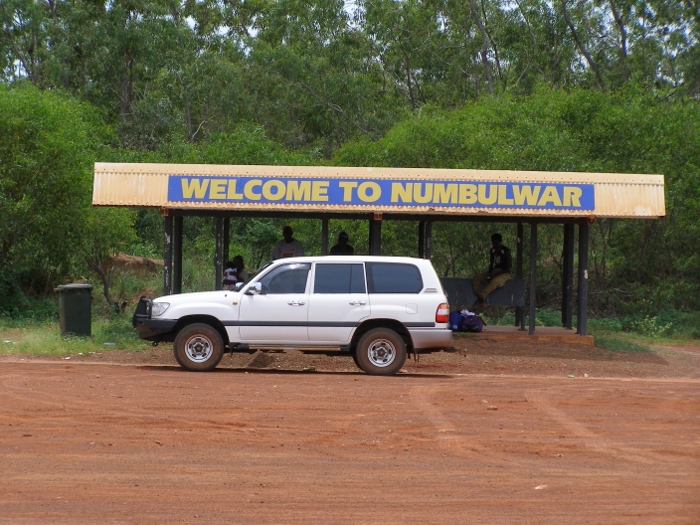
The Numbulwar airport
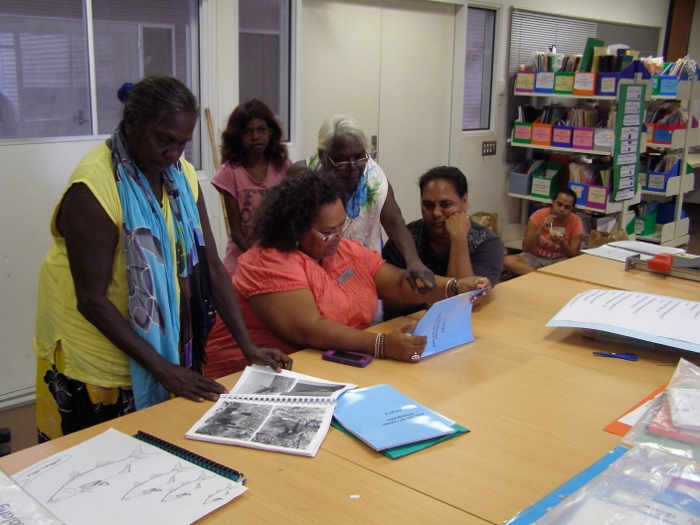
The women Faye Manggura , Ella Geia and Jangu Nundhirribala – drawing the project , a first look at the photo’s.
Men Only (Tuesday, February 25, 2014)
Starting today a number of local women and I prepare the ‘exhibition’. Jangu (pronounced: Djangoe) Nundhirribala is the most enthusiastic of all and works tirelessly. She tells me stories and names of people appearing in the Alex van der Leeden photos. The women have also ensured me that the old men will view the photographs first to see which photos are suitable for the general public.
Around 9am, two men came into the schoolroom where we worked. Their names are Ernest Numamudidi and Laalbid (John) Nunggargalu and they take four albums to the side to look through. Laalbid found a photo of himself as a young boy (a ongetrouwde man) with Alex van der Leeden. He said that he went everywhere “with that old man” and that he worked for the researcher as a young boy.
After a while, Ernest tells me each photo that needs to be labeled ‘restricted’ that cannot be seen by the women in the community. We agree that these images will be labeled as ‘men’s only’. Although this process did not seem too difficult, it soon became apparent just how serious the community is about what can be considered appropriate for public viewing and what is viewed as ‘men’s only’ pictures.
Later when some pictures are shown via a projector some women want to leave the room feeling that they should not be looking at those images. Even though the male elders did not restrict these images, I removed these images out of respect for the women anyway. A little later the women assured me not to worry about the fact that I had seen those pictures because I was not in the culture. The photographs may not touch me.
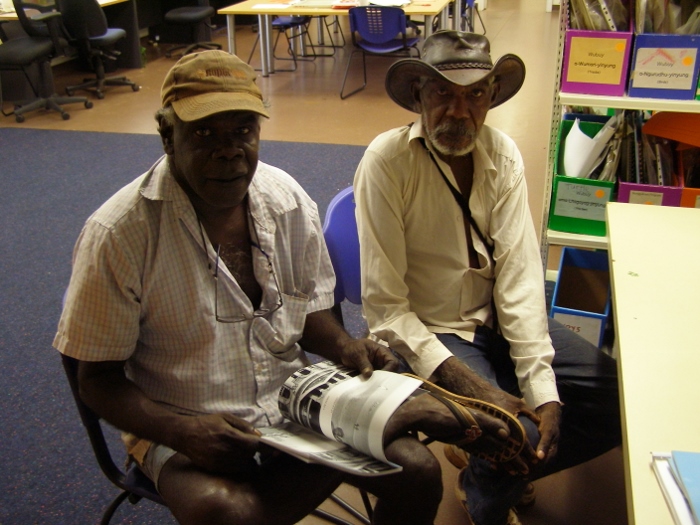
Ernest Numamudidi and Laalbid Nunggargalu look at the photo albums
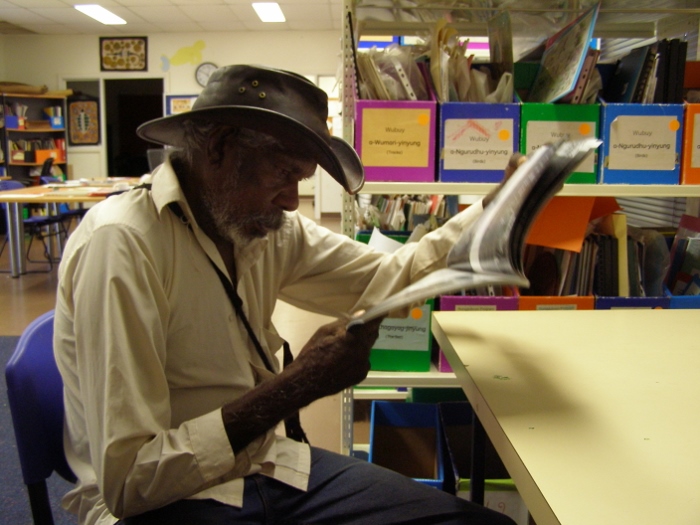
Laalbud Nunggargalu sees himself in a photo.
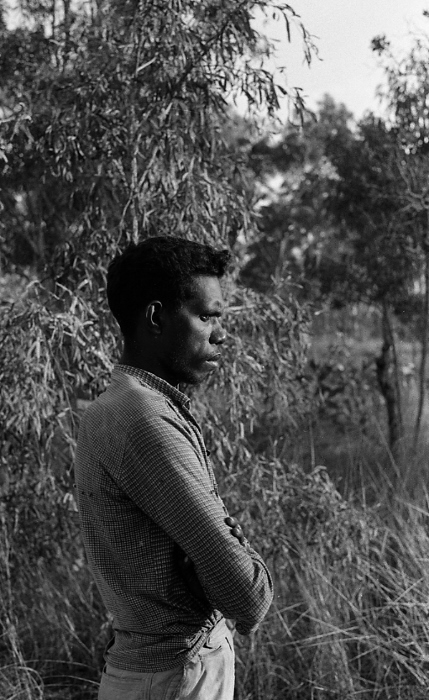
A much younger Laalbid Nunggarfalu photographed on May 30, 1964 at the Amayadiruid campground.
The exhibition “I can not avert my eyes to these pictures (Wednesday, February 26 2014)
The ‘van der Leeden exhibition” will open today. People in the settlement waited impatiently the opening. They wanted to see if there were images of their families or themselves. Together with a number of women we have set up the exhibition in the language classroom of the local school.
People are able to view printed images through a selection of plastic wallets that are hung on a wall of the room. Also a projector had been set up to project photographs that were not restricted and could be viewed by woman and children and available to all. We have placed the ‘restricted’ photos in albums (that had been marked clearly) in a secluded area that were only available to men. The men took this opportunity to view these images at length.
It’s great to see all these happy faces. Suddenly Leonie Murungun exclaimed on seeing a picture of her aunt: “I can not stop looking at this picture”. Her statement depicts the overall atmosphere of the exhibition.
The visitors often stay longer than an hour because there is so much to see in the displayed pictures, photo albums and the whole slideshow. Some visitors came even two or three times. In the beginning it was mainly women, but as the day progressed, there were more and more men.
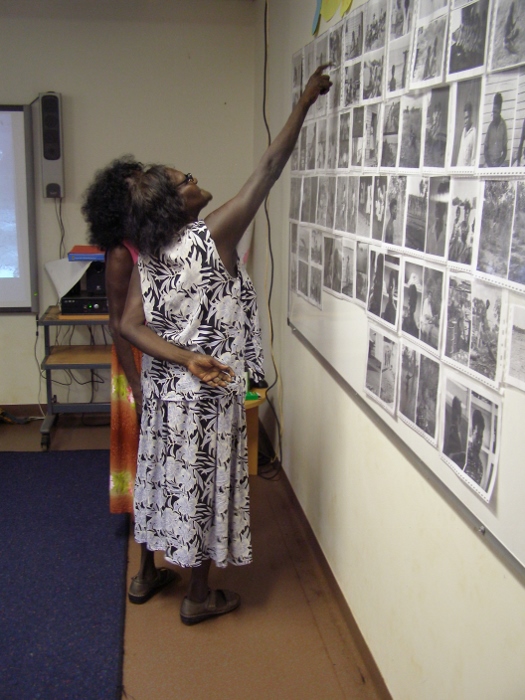
Leonie Murungun exclaims, “I can not stop looking at this picture”.
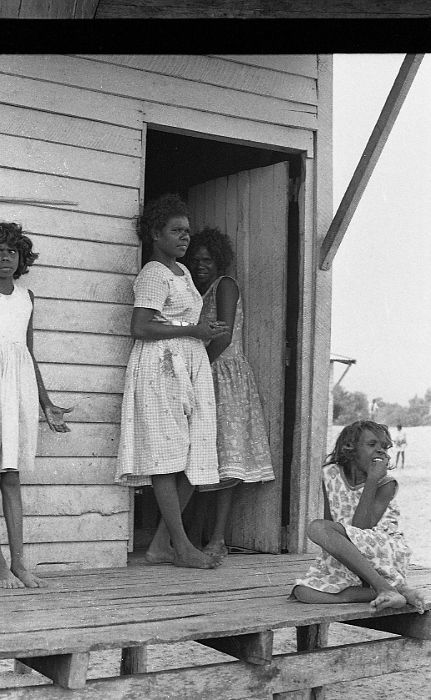
Leonie Murungun is the girl sitting on the right of the jetty
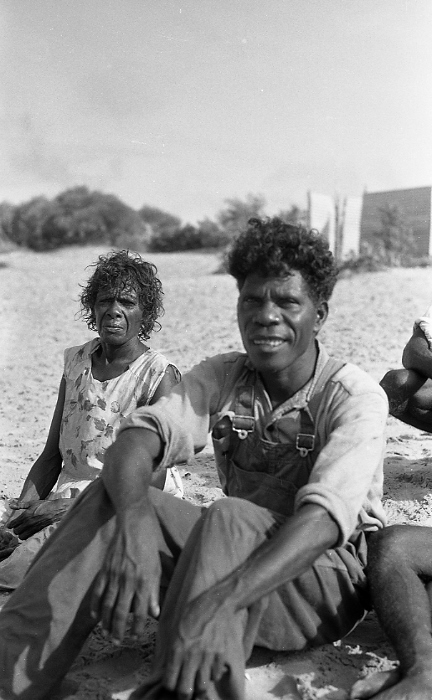
Aunt Leonie Murungun , Yingginggi Murungun and Mack Nunggargalu
Relationships (Thursday, February 27 2014)
Today the exhibition continues to attract local residents. The local school brings the school children to look at the exhibition. Jangu Nundhirribala again works tirelessly explaining to the children how everyone is related, and how important it is to understand these relationships. Jangu talked to the children the entire time in Wubuy, the local language. Occasionally she comes up with an English phrase like “You’ve got to understand the relation,” which again underlines its importance. When the children become tired and a little distracted, they call them to order and reiterate just how important these photos are. They belong to their history.
Kinship in Numbulwar and the Nunggubuy in general is very complex. There are relatives and classificatory kin. For example, a person’s mother or father can have that role without being their biological parents. During his research, Alex van der Leeden was investigating the entire system. There are six clans and six clans of mixed origin. In addition, the population is divided into two halves moieties or population. Each clan has their own rituals, their own sacred places and totems.
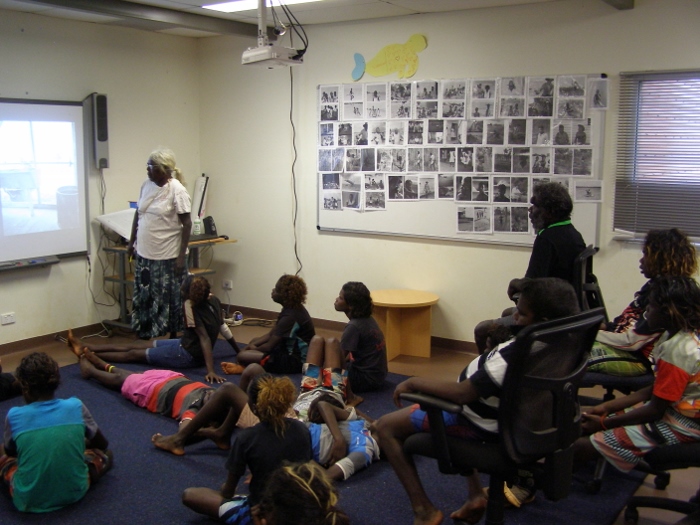
Jangu Nundhirribala discuss the photographs to the school children.
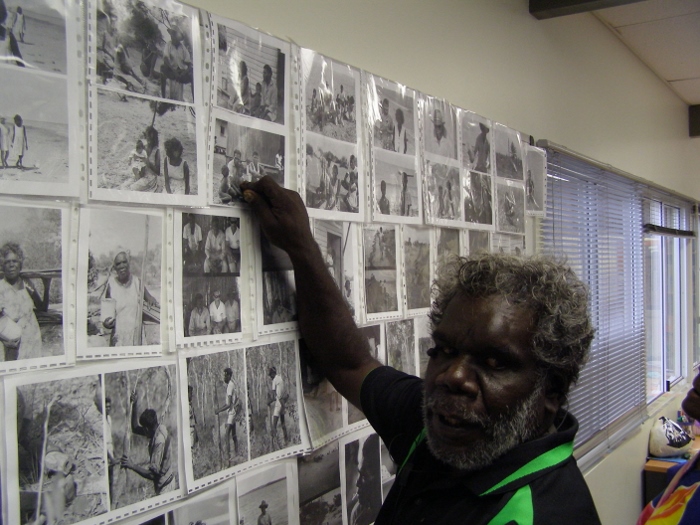
Paul Numamudidi points at himself in the photo
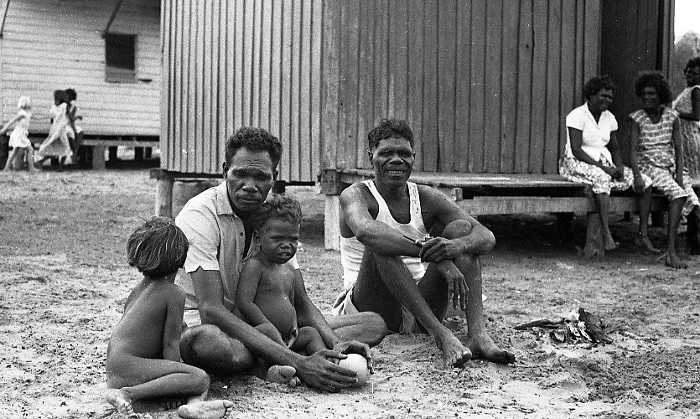
Paul Numamudidi sitting on the lap of his father Peter Numamudidi
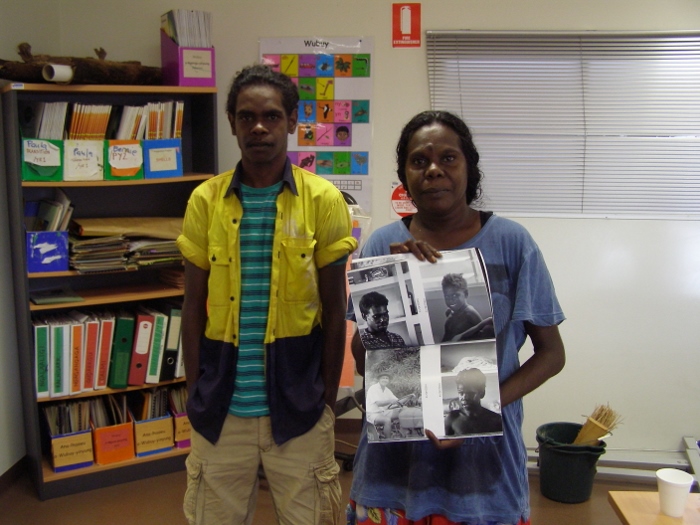
Kristie Nundhirribala and her son Jackson. They hold an album determined to see a photo of her father, Buguju Nundhiribaka
Reminders (Friday, February 28, 2014)
It’s nine o’clock in the morning and we have already been asked if the exhibition open today. Shortly afterwards, two men entered who viewed the photographs quite extensively. They laugh a lot upon finding photographs of themselves or other family members. Many stories were told, mostly in Wubuy.
The photos bring positive memories, a stories of a time where there were no boats and where the boys and men had built all the houses themselves; a time where the children and their parents only had just made the transition from a nomadic to a sedentary existence.
People could not get enough of it. One man told me he had been yesterday, but he came once again because it was so good to see all those memories. The fact that these pictures were visible on their computer is also reassuring for the residents of Numbulwar. Even if I’m gone, they can still look at the pictures.
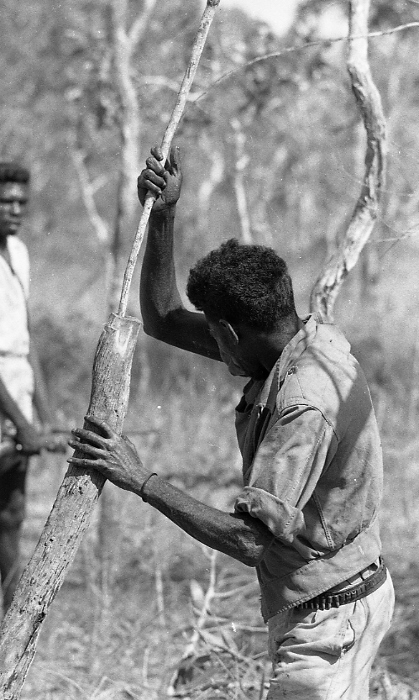
Arrama Ngalmi and Laalbid Nunggargalu make a didgeridoo

Minjuugag Nunggamaijbar also called Young Reuben testing the boomerang he has just made
Grandmother (Saturday 1 March 2014)
Except for the girls who work in the local supermarket, everyone is free on weekends. Today we planned to reap pandanus with the women, but it turned out to be too wet. So much so that it rained for eight hours making the roads all soggy.
Later in the day Jangu decided to take a walk to catch crabs that we could use as bait when fishing. The walk follows the coastline at the rising tide. Jangu shows me different places that are also seen in the pictures of Alex van der Leeden. She tells me that we cannot swim in the sea because of the sharks and also have to watch out for crocodiles.
We are lucky with the weather and listening to her stories is very enjoyable. Upon our return to my residence, we organize to meet up with other locals to go fishing after lunch.
Then Jangu informs me that she now considers me her Ngaragaagu, (her grandmother). We both find it funny that I’ve become the grandmother of someone who is twice as old as me. I now belong to the Nunggargalu clan. We have little luck at fishing and come without anything back home.
I will always remember this day, as the day I became a ‘grandmother’!
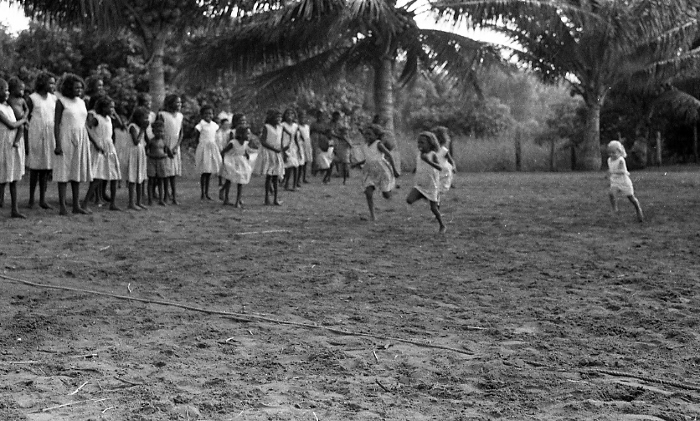
Girls playing sport in Montgomery Park
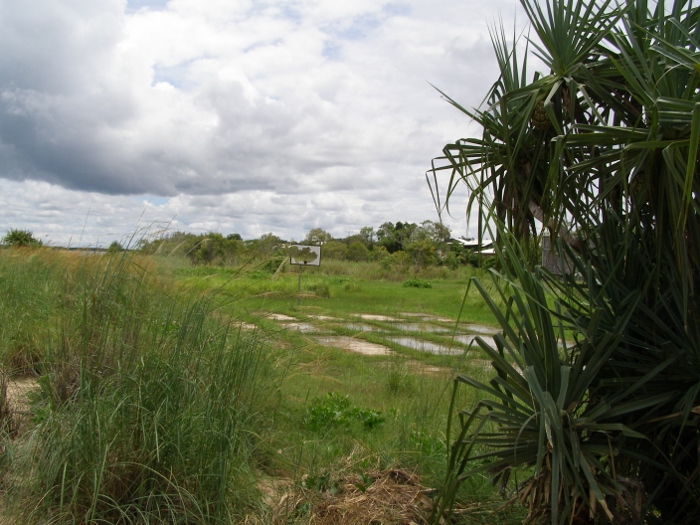
Montgomery Park is no longer in use

Jangu throwing a fishing line